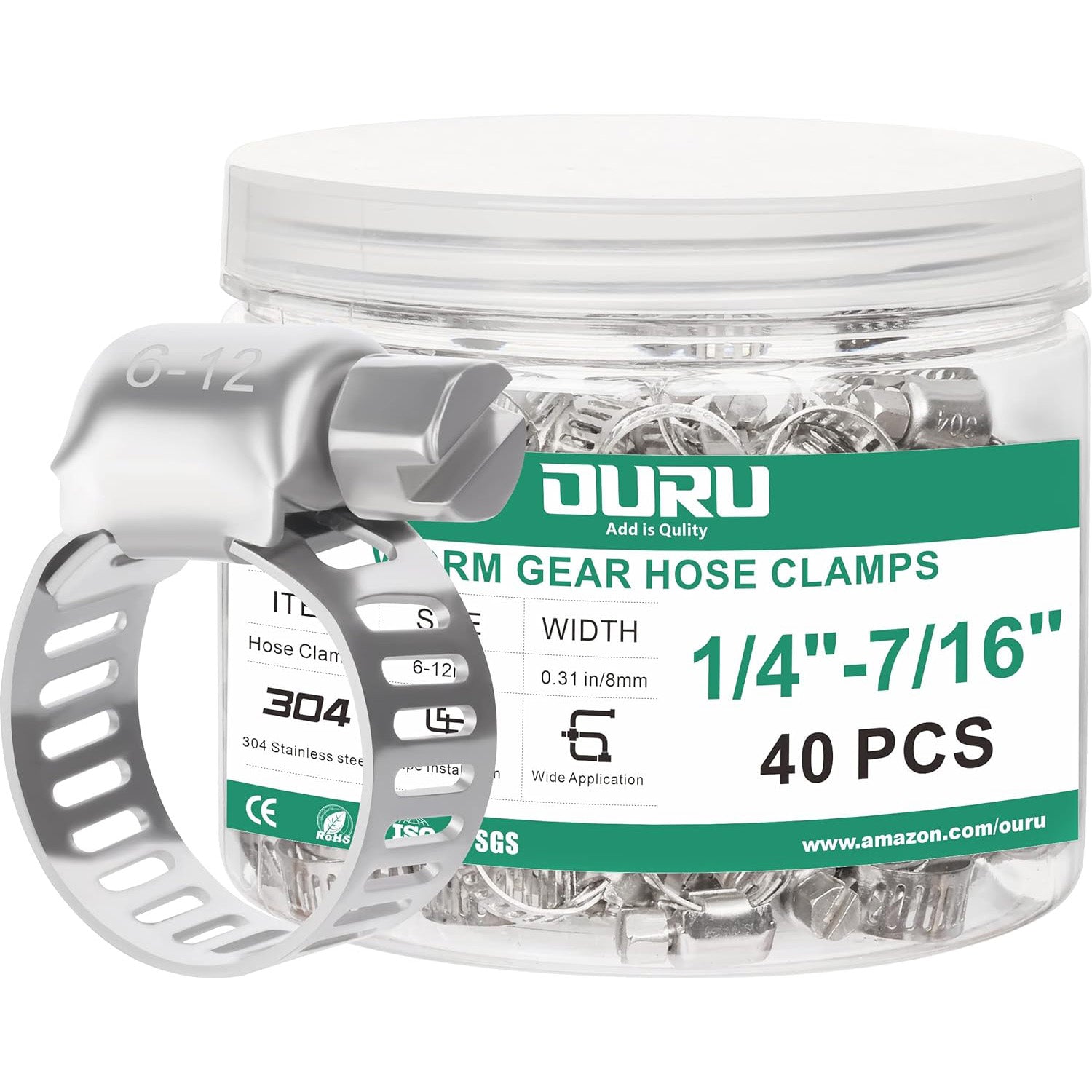With over 10,000 orders
With over 10,000 orders

A mechanic loosening a worm gear hose clamp with a screwdriver. Using the proper tools makes opening pipe clamps safe and easy.
Before opening a clamp, gather the right tools. A flat-head screwdriver or nut driver works for worm gear clamps (the common stainless steel hose clamps with a screw). For spring hose clamps (the squeeze-to-release kind on coolant or fuel lines), use pliers or special hose clamp pliers. It’s also smart to have side cutters or tin snips for any ear clamps that need cutting. Penetrating oil can help with rusted screws, and gloves and eye protection will keep you safe from sharp metal or sprays. Having quality tools – and spare clamps ready – makes the job easier. For convenience, keep an Ouru Hose Clamps Kit in your toolbox; it has durable stainless clamps in assorted sizes so you’re always prepared to replace an old clamp.
Worm Gear Clamps: These metal band clamps tighten with a screw (also called worm drive clamps). To open one, insert a flat screwdriver into the screw head and turn counterclockwise to loosen. The band will expand and the clamp will loosen its grip. Once it’s slack, slide the clamp off the hose. Use the right size driver to avoid stripping the screw. If the clamp is old or rusty, it’s best to replace it with a new stainless hose clamp from the Ouru kit for a secure seal.
Spring Hose Clamps: These are the circular spring-steel clamps with two tabs that you squeeze to release. Squeeze the tabs together using pliers (or dedicated spring clamp pliers) to open the clamp. While keeping it compressed, slide it off the hose fitting, then carefully let it go. Be mindful of the clamp’s spring force so it doesn’t snap on your fingers. If spring clamps are tricky to work with, you can replace them with easier-to-use worm gear clamps (stainless steel) from the Ouru assortment when reassembling.
T-Bolt Clamps: These heavy-duty clamps use a bolt and nut to tighten. Use a wrench or socket to loosen the nut (turn it counterclockwise) until the clamp’s band opens up. Then lift the clamp off the hose. T-bolt clamps are often used on large or high-pressure hoses. Ouru’s 304 stainless steel clamps can serve as reliable replacements for old T-bolt clamps, since they resist corrosion even in harsh conditions.
Ear Clamps: These one-time-use clamps have an “ear” section that is crimped to tighten. To remove an ear clamp, use side cutters or an ear clamp tool to cut the crimped ear and break the clamp’s loop. Once the ear is snipped, the clamp will spring loose and can be taken off the hose. Take care not to nick the hose itself when cutting. Since ear clamps aren’t reusable, you’ll need to replace it – an equivalent-size screw clamp from the Ouru kit is a handy substitute.
Stubborn clamps happen – maybe the screw is rusted or the clamp is fused to the hose. If a screw-type clamp won’t turn, spray a bit of penetrating oil on the screw threads and wait a few minutes. This can loosen the rust. Use the correct screwdriver and push firmly to avoid stripping the head. If it still won’t budge or the screw is stripped, you might have to cut the clamp off and put on a new one from your Ouru kit to solve the problem.
If the clamp is stuck to the hose (for example, the rubber has bonded to the metal over time), try twisting the hose gently to break that bond once the clamp is loosened. You can also carefully wedge a flat screwdriver under the clamp’s band to pry it up from the hose surface – do this slowly to avoid damaging the hose. In a worst-case scenario (like a completely rusted clamp or a crimped ear clamp that won’t cut), it’s safest to cut the clamp off entirely with snips or a small hacksaw. Once the broken clamp is removed, clean away any rust, then install a new stainless steel clamp. Always swap out a corroded clamp with a quality stainless replacement to prevent future problems. Ouru’s clamps are made of 304 stainless steel, so they won’t rust or seize like ordinary clamps – a smart upgrade for peace of mind.
Opening hose clamps is manageable for any DIYer with the right approach. Remember to relieve any pressure in the system first (for example, let pipes cool or drain fluid) before undoing a clamp. We covered how to handle worm gear, spring, T-bolt, and ear clamps using the proper tools and methods for each. If a clamp is stubborn, take your time with penetrating oil or by carefully cutting it off instead of forcing it. Replacing old clamps with new stainless steel ones is a smart safety step. With a bit of patience and the tips above, you can confidently deal with pipe clamps on your car, appliances, or plumbing. And don’t forget: keeping an Ouru Hose Clamp Kit on hand means you’ll always have the right size clamp ready for your next project!
References:
cntopa.com
hcl-clamping.co.uk
essentracomponents.com
{"one"=>"Select 2 or 3 items to compare", "other"=>"{{ count }} of 3 items selected"}
Leave a comment